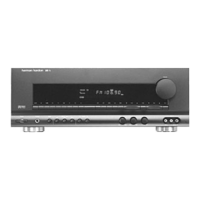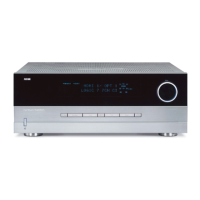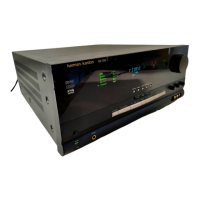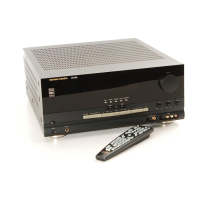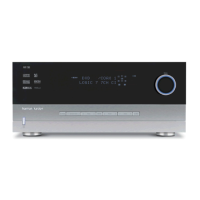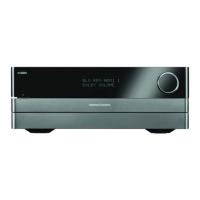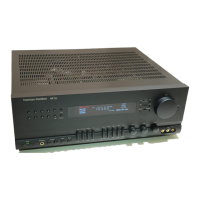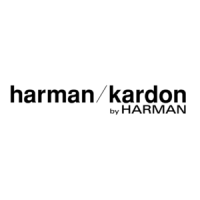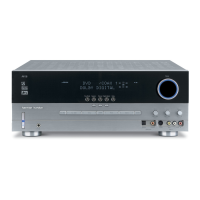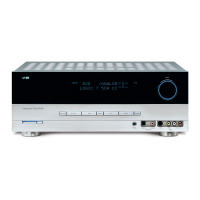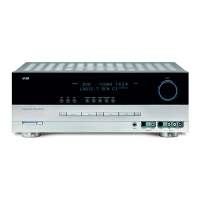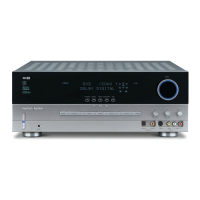OPERATION
28 OPERATION
• When an audio source is selected,the last video input
used remains routed to the Video 1/Video 2
Outputs ¢⁄ and Video Monitor Outputs d.
This permits simultaneous viewing and listening to
different sources.
•
When a composite or S-Video source is selected,the
video signal for that input will be routed to the
Video
Monitor Output
d
and will be viewable on a TV
monitor connected to the AVR 7200.
6-Channel/8-Channel Direct Input
• There are four input choices available for use with
sources such as a DVD-Audio or SACD player that are
connected to the
8-Channel Direct Inputs .
Select the appropriate input according to the way your
system and source equipment is configured:
■ The 6CHDIRECT input should be used
when the SBR and SBL inputs are NOT in use
and the input source device has its own internal
bass management system.This input passes the
input from the source directly through to the vol-
ume control without any analog to digital conver-
sion and it mutes the unused input jacks to pre-
vent unwanted noise from interfering with system
performance.
■ The 6CHDVD AUDIO input should be
used when the SBR and SBL inputs are NOT in
use and the input source device does NOT have
its own internal bass management system.When
this input is in use the analog source is converted
to digital so that you may use the same Triple
Crossover bass management options for the
direct input as you do with all other outputs.This
input also mutes the unused input jacks to pre-
vent unwanted noise from interfering with system
performance.
■ The 8CHDIRECT INPUT should
be used when an input is connected to all eight
8-Channel Direct Inputs and when the
input source device has its own internal bass
management system.This input passes the input
from the source directly through to the volume
control without any analog to digital conversion
and it mutes the unused input jacks to prevent
unwanted noise from interfering with system
performance.
■ The 8CHDVD AUDIO input should
be used when an input is connected to all eight
8-Channel Direct Inputs and the input
source device does NOT have its own internal
bass management system.When this input is in
use the analog source is converted to digital so
that you may use the same Triple Crossover bass
management options for the direct input as you
do with all other outputs.This input also mutes
the unused input jacks to prevent unwanted noise
from interfering with system performance.
Volume Control
•Adjust the volume to a comfortable level using the
front panel Volume Control ı or remote Volume
Up/Down Buttons r .
•Totemporarily silence all speaker outputs, press the
Mute Button K .This will interrupt the output
to all speakers and the headphone jack, but it will
not affect any recording or dubbing that may be in
progress.When the system is muted, the word
MUTE will flash in the Main Information Display
˜. Press the Mute Button K again to
return to normal operation.
•You may adjust the bass and treble tone controls at
any point during a listening session by simply turning
the
Bass Control Ô or Treble Control Ò until
the desired setting is achieved.You may also totally
remove the tone controls (including the
Balance
Control ) from the circuit so that the output is
“flat” at any time by pressing the Tone Mode
Button 5 and then pressing the
‹/› Buttons
)# so that TONE OFF appears in the on-
screen display and the Lower Display Line B .
•For private listening, plug the 1/4" stereo phone
plug from a pair of stereo headphones into the
front-panel
Headphone Jack
4
.When the
headphone’s plug is connected,the word
HEADPHONE will scroll once across the
Lower Display Line B and all speakers will be
silenced.When the headphone plug is removed, the
audio feed to the speakers will be restored.
Surround Mode Selection
Selection of a surround mode is based on personal
taste,as well as the type of program source material
being used. For example,motion pictures or TV pro-
grams bearing the logo of one of the major surround-
encoding processes,such as Dolby Surround, DTS
Stereo or UltraStereo
® may be played in either the
Dolby Digital, Dolby Pro Logic II Cinema, DTS Neo:6
Cinema, or Logic 7 Cinema surround modes depending
on the source material.
NOTE: Once a program has been encoded with matrix
surround information, it retains the surround information
as long as the program is broadcast in stereo.Thus,
movies with surround sound may be decoded via any
of the analog surround modes such as Pro Logic II
Cinema, Logic 7 Cinema or DTS Neo:6 Cinema, when
they are broadcast via conventional TV stations,cable,
pay-TV and satellite transmission. In addition, a growing
number of made-for-television programs,sports broad-
casts,radio dramas and music CDs are also recorded in
surround sound.You may view a list of these programs
at the Dolby Laboratories Web site at www.dolby.com.
Even when a program is not listed as carrying intentional
surround information, you may find that the Pro Logic II,
Logic 7 Enhanced or DTS Neo:6,VMAx and the Hall or
Theater modes often deliver enveloping surround pre-
sentations through the use of the natural information
present in all stereo recordings.
Surround modes may be changed at any time by
using either the front panel or remote control.To
select a new surround mode from the front panel, first
press the
Surround Mode Group Selector Button
7 until the desired major surround mode group such
as Dolby, DTS or Logic 7 is selected.Next, press the
Surround Mode Selector Button 8 to choose the
specific individual surround mode.
To select a surround mode using the remote,press
the button for the major surround mode group that
you wish to choose from:
Dolby , DTS Surround
, DTS Neo:6 , Logic 7 h, Stereo
or DSP Surround g. The first press of the button
will show the current mode from that group if it is
already in use,or the first available mode if you are
currently using another mode.To cycle through the
modes in that group,press the button again until the
desired mode appears in the
Lower Display Line B
and the on-screen display.
As the surround modes change,a green LED will light
next to the current mode in the
Surround Mode
Indicators
˘ list on the front panel.
The Dolby Digital, Dolby Digital EX and DTS 5.1,
DTS-ES Matrix and DTS-ES Discrete modes may only
be selected when a digital input is in use.In addition,
when a digital source is present, the AVR 7200 will
automatically select and switch to the correct mode,
regardless of the mode that has been previously
selected. For more information on selecting digital
sources,see the Digital Audio Playback section below.
NOTE: When a single speaker is used for the rear
surround channels as a 6.1 configuration, the Logic 7/
7.1 and 7-Channel Stereo modes should not be
used. However, Dolby Digital EX and DTS will function
normally.
When the 6-channel/8-channel direct inputs are in
use there is no surround processing, as these inputs
take the analog output signals from an optional, exter-
nal DVD-Audio or SACD player, or another source
device and carry them straight through to the volume
control without any further digital processing.
38
39
32
32
34
34
34
AVR 7200 OM 1/27/03 4:46 PM Page 28
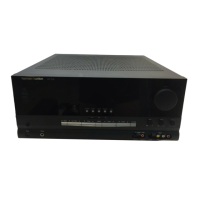
